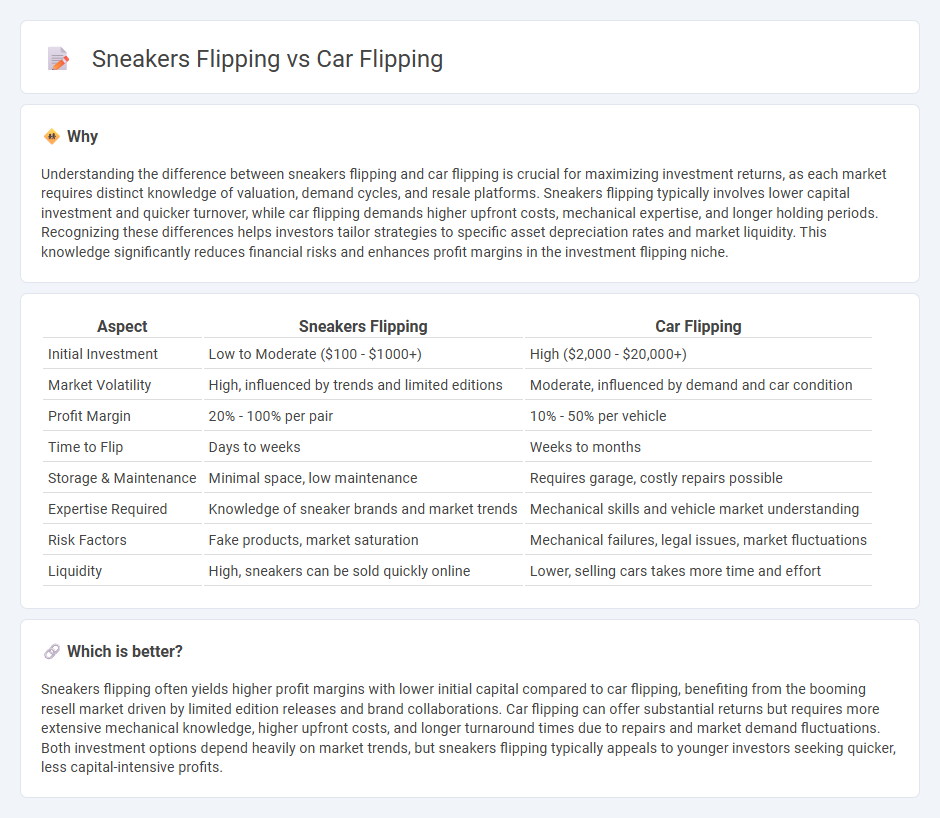
Sneakers flipping involves buying limited-edition or high-demand sneakers at retail prices and reselling them at a profit, capitalizing on trends and brand collaborations. Car flipping requires purchasing undervalued or damaged vehicles, refurbishing them, and selling for a higher price, often demanding mechanical skills and knowledge of the automotive market. Explore detailed strategies and market insights to maximize returns in either sneakers or car flipping investments.
Why it is important
Understanding the difference between sneakers flipping and car flipping is crucial for maximizing investment returns, as each market requires distinct knowledge of valuation, demand cycles, and resale platforms. Sneakers flipping typically involves lower capital investment and quicker turnover, while car flipping demands higher upfront costs, mechanical expertise, and longer holding periods. Recognizing these differences helps investors tailor strategies to specific asset depreciation rates and market liquidity. This knowledge significantly reduces financial risks and enhances profit margins in the investment flipping niche.
Comparison Table
| Aspect | Sneakers Flipping | Car Flipping |
|---|---|---|
| Initial Investment | Low to Moderate ($100 - $1000+) | High ($2,000 - $20,000+) |
| Market Volatility | High, influenced by trends and limited editions | Moderate, influenced by demand and car condition |
| Profit Margin | 20% - 100% per pair | 10% - 50% per vehicle |
| Time to Flip | Days to weeks | Weeks to months |
| Storage & Maintenance | Minimal space, low maintenance | Requires garage, costly repairs possible |
| Expertise Required | Knowledge of sneaker brands and market trends | Mechanical skills and vehicle market understanding |
| Risk Factors | Fake products, market saturation | Mechanical failures, legal issues, market fluctuations |
| Liquidity | High, sneakers can be sold quickly online | Lower, selling cars takes more time and effort |
Which is better?
Sneakers flipping often yields higher profit margins with lower initial capital compared to car flipping, benefiting from the booming resell market driven by limited edition releases and brand collaborations. Car flipping can offer substantial returns but requires more extensive mechanical knowledge, higher upfront costs, and longer turnaround times due to repairs and market demand fluctuations. Both investment options depend heavily on market trends, but sneakers flipping typically appeals to younger investors seeking quicker, less capital-intensive profits.
Connection
Sneakers flipping and car flipping both represent niche investment strategies focused on buying undervalued or limited-edition items and reselling them at a profit, leveraging market demand and rarity. Both rely heavily on market research, timing, and an understanding of consumer trends to maximize returns. Investors capitalize on the appreciation of these tangible assets, turning passion and expertise into profitable ventures.
Key Terms
Car flipping:
Car flipping involves purchasing vehicles at lower prices, often damaged or undervalued, then repairing and reselling them for a profit. This practice requires knowledge of auto mechanics, market trends, and negotiation skills to maximize returns on investments. Explore the key strategies and tips to excel in car flipping and boost your income.
Depreciation
Car flipping involves navigating significant depreciation, as vehicles typically lose 20-30% of their value within the first year, impacting potential profit margins more severely than sneakers. Sneakers, particularly limited editions or collaborations, often appreciate in value over time due to scarcity and demand, making depreciation less of a concern. Explore strategies for maximizing returns in both markets by understanding depreciation dynamics in detail.
Title transfer
Car flipping requires careful handling of title transfer to avoid legal issues, ensuring the vehicle's ownership is properly and promptly recorded with the DMV. Sneakers flipping involves verifying authenticity and condition but lacks formal title transfer processes, relying more on trust and documentation from resellers. Discover more about the intricacies of title transfer and ownership verification in both markets.
Source and External Links
How To Make Money Flipping Cars | Car Flipping Guide - Car flipping involves buying used or new cars, making repairs or upgrades, and selling them quickly for a profit, with an average profit of about $1,200 per car but requiring knowledge of laws, market, and mechanical work.
Flipping Cars| Off-Topic Discussion forum | - Grassroots Motorsports - Flipping cars means purchasing undervalued cars, cleaning, repairing mechanical parts, and selling them for a profit, with considerations of market changes and costs involved in the process.
How To Flip Cars | FULL PROCESS - YouTube - A detailed video explaining the entire car flipping process including inspecting damage, making repairs such as headlight replacement and restoration, and prepping cars for sale to maximize profit.
 dowidth.com
dowidth.com